Patti Labelle and the
BlueBelles

1963 (clockwise frim top) Sarah
Dash, Cindy Birdsong. Nona
Hendryx, Patti Labelle
In their 16 years together, LaBelle developed from a fairly
conventional Sixties girl group, completed with sequined gowns,
buffants and polished choreography into a band with a unique
space queen look, an idealistic political consciousness and an
individual gospel tinged funky rock and roll sound. Yet they
might not have had a career if it had not been for another group.
Members:
(1962-1967)
Patricia Holte (LaBelle)
Sarah Dash
Nona Hendryx
Cindy Birdsong
|
(1967-!970)
Patti Labelle
Sarah Dash
Nona Hendryx
|
(1971-1976) LaBelle
Patti LaBelle
Sarah Dash
Nona Hendryx
|
Patti Labelle was born Patricia Holt in 1944. Patti's earliest
years were spent much like those of her musical contemporaries -
singing in church. It was the choir at the local Beulah Baptist
Church that gave Patti as youngster her first opportunity to vent
to her natural vocal gifts. Like other girls growing up in the
'50s, the idea of forming a vocal group was a natural. With
Cynthia "Cindy" Birdsong, Patti formed The Ordettes and
by 1961, the two school friends had hooked up with Wynona
"Nona" Hendryx and Sarah Dash - singers from The Del
Capris, a rival female group to form The Bluebells.

Around the same time another female quartet, The Starlets,
were on tour due to the success of their single "Better Tell
Him No." While in Philadelphia for some one nighters
they were convinced by Harold Robinson, a used car dealer, to
come to his studio and record a few sides. Out of that session
came "I Sold My Heart to the Junkman."
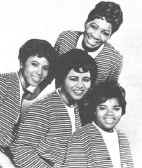
Clockwise from the left
Cindy Birdsong, Pattie LaBelle, Sandra Dash, Nona Hendryx
Whether the Blue Belles heard the recording
before its release isn't known, but when Newton Records released
the Starlets' recording in late 1961/ early 1962 the name on the
label was The Blue-Belles. By June, the record was #15 Pop and
#13 R & B, giving the Blue Belles their first hit without
ever being in the studio. Their first actual recording didn't
fare as well. Their second "real" release, a ballad
"Go On" gave an indication of things to come, and their
harmonies on "Cool Water indicated that they could sing
better given better material. The Blue Belles third single
of 1963 met those qualifications as Patti through the melody of
"Down the Aisle" accompanied by the Blue Belles'
angelic sounding higher than high warbling.. "Down the
Aisle" went to #37 Pop and #14 R & B, setting the stage
for the group to sing big ballads and old standards. In January,
1964 they released Rodgers and Hammersteins' classic "You'll
Never walk Alone," which went to #34 on both the Pop and R
& B charts. What "Down the Aisle did to establish the
group, "You'll Never Walk Alone" did to establish Patti
as one of the most powerful and distinctive vocalists ever.

The Blue-Belles as they looked on American Bandstand
From top (l-r) Cindy Birdsong, Pattie LaBelle Sandra Dash
Bottom: Nona Hendryx
Building a reputation as a dynamic vocal outfit
who brought energy and excitement to their live performances,
Patti and The Blue Belles spent their first few years building a
solid R&B base by performing on the "chitlin
circuit," a series of theaters in cities like New York,
Chicago, Washington D.C., Atlanta, Detroit, Baltimore, and
Philadelphia that featured package shows with hit R&B stars
of the day.
Pattis began incorporating her high-note finale
into new recordings such as "Dany Boy" (#4 Pop and
R&B 1964) which turned out to be the Blue Belles last of
three singles for Parkway Records.
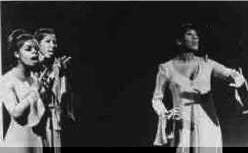
In the middle of 1965 the group signed with
Atlantic Records. The group's first Atlantic album included a
number of standards and popular songs of the day:
The group's three-year stay with Atlantic proved less than
successful: only two singles - "I'm Still Waiting" and
"Take Me For A Little While" - saw any chart action and
in spite of two fine albums and a collection of strong singles,
Patti and The Blue Belles (reduced to a trio with the departure
of Cindy who replaced the late Florence Ballard as a member of
The Supremes in 1968) were in need of a new attitude.
1975 LaBelle
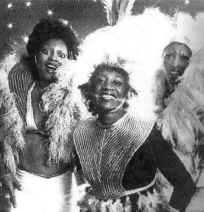
(L-R) Sarah Dash, Patti LaBelle, Wynona Hendrix
In 1970 Vicki Wickham, a British television
producer who had produced the group on Ready, Steady, Go!
the U.K.'s hippest '60s music program took over their
management. The first change was to rename the group
LaBelle. Wickham had a vision that saw a shift in visual image
and musical approach of LaBelle. Next the group signed with
Warner Brothers and toured with White rockers like the Who
instead of the usual soul circuit. Labelle recorded two
progressive albums that featured an eclectic fusion rock and
R&B. While neither album was commercially successful, tracks
like "Morning Much Better" and Cat Stevens'
"Moonshadow" became favorites among the cult audience
that began following the trio in the '70s.
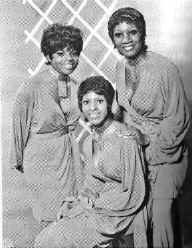
Last photo as the Bluebbelles 1970
(clockwise from left) Sarah Dash, Patti LaBelle, Nona Hendryx
As the glitter era of rock's early 70s took hold,
LaBelle began appearing in their now famous silvery space suits
and luminous makeup.
A one-off album for RCA, 1973's Pressure Cookin' still
failed to take LaBelle to the masses although word of mouth was
spreading and it became apparent that a hit single could be the
key to taking the group to a new level of popularity. After
signing with Epic Records in 1974, the tide turned. LaBelle went
down to New Orleans to work with (producer) Allen Toussaint on
our first album for the company. The trio's first album for Epic
was entitled Night Birds. One cut from the album
"Lady Marmalade," a catchy ditty about a Crescent City
hooker became an million-selling #1 pop and R&B smash
in early 1975. The song's success led to the group's first gold
album, Nightbirds which contained classic tracks like
the follow-up single, "What Can I Do For You," and
"Are You Lonely". Three of their next four
singles charted, but none with anything resembling the excitement
generated by "Lady Marmalade". After two more excellent
albums (Phoenix and Chameleon) musical
differences between Patti and Nona began to pull the group apart.
By 1977, their last single "Isn't It a
Shame," came out unnoticed and the group split. Sarah moved
on moved to Kirshner Records for two low chart releases in 1979,
"Sinner Man" and "(Come and Take This) Candy From
Your Baby." Nona became a rock and roller, playing with New
York bands Propaganda and Material. In 1983 she signed with RCA
and had five charted singles though none went higher than #22.
Her biggest hit for EMI America in the spring of 1987 was
"Why Should I Cry."
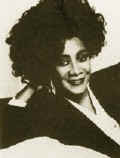
Patti continued on Epic having eight chart
singles between 1977 and 1980, though none went higher than
number twenty-six. Her solo career took of when she signed with
Philadelphia International Records in 1981 and had a number one
R&B hit with "If I Only Knew." A succession of
duets ("Love Has Finally Come" with Bobby Womack and
"On My Own" with Michael McDonald) and songs from
movies ("New Attitude" and "Stir It Up" from
Beverly Hills Cop, "Something Special" from Outrageous
Fortune, and Just the Facts from Dragnet) kept her in the
spotlight ever since.
As for the Blue Belles/LaBelle, any act that remained together
for sixteen years with no addition and only one member leaving
certainly deserves recognition.
LaBelle was inducted on to the Philadelphia
Alliance Walk of Fame in 2017.
Patti LaBelle was inducted on to the Philadelphia
Musical Alliance in 1990.
Sarah Dash died September 20, 2021.








